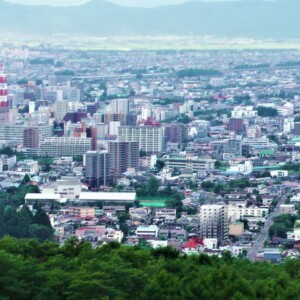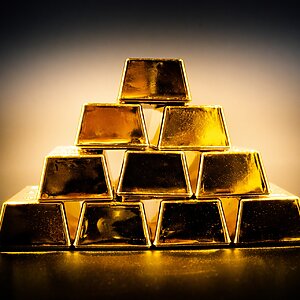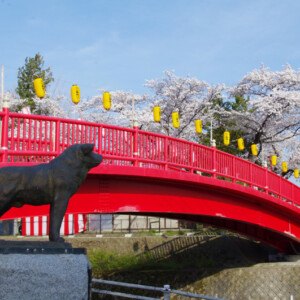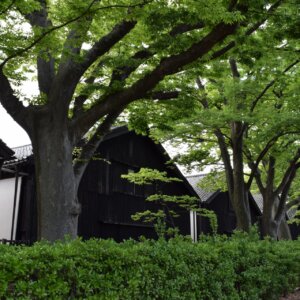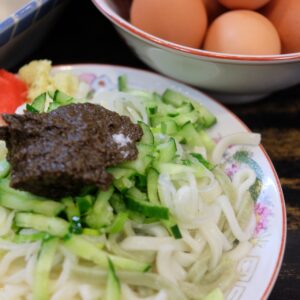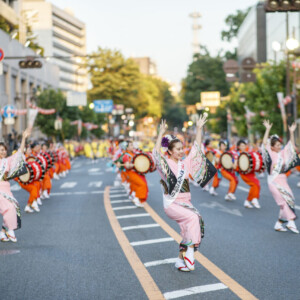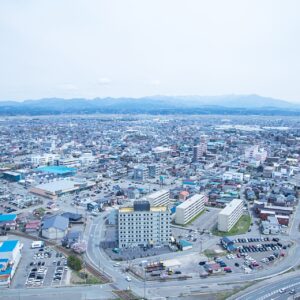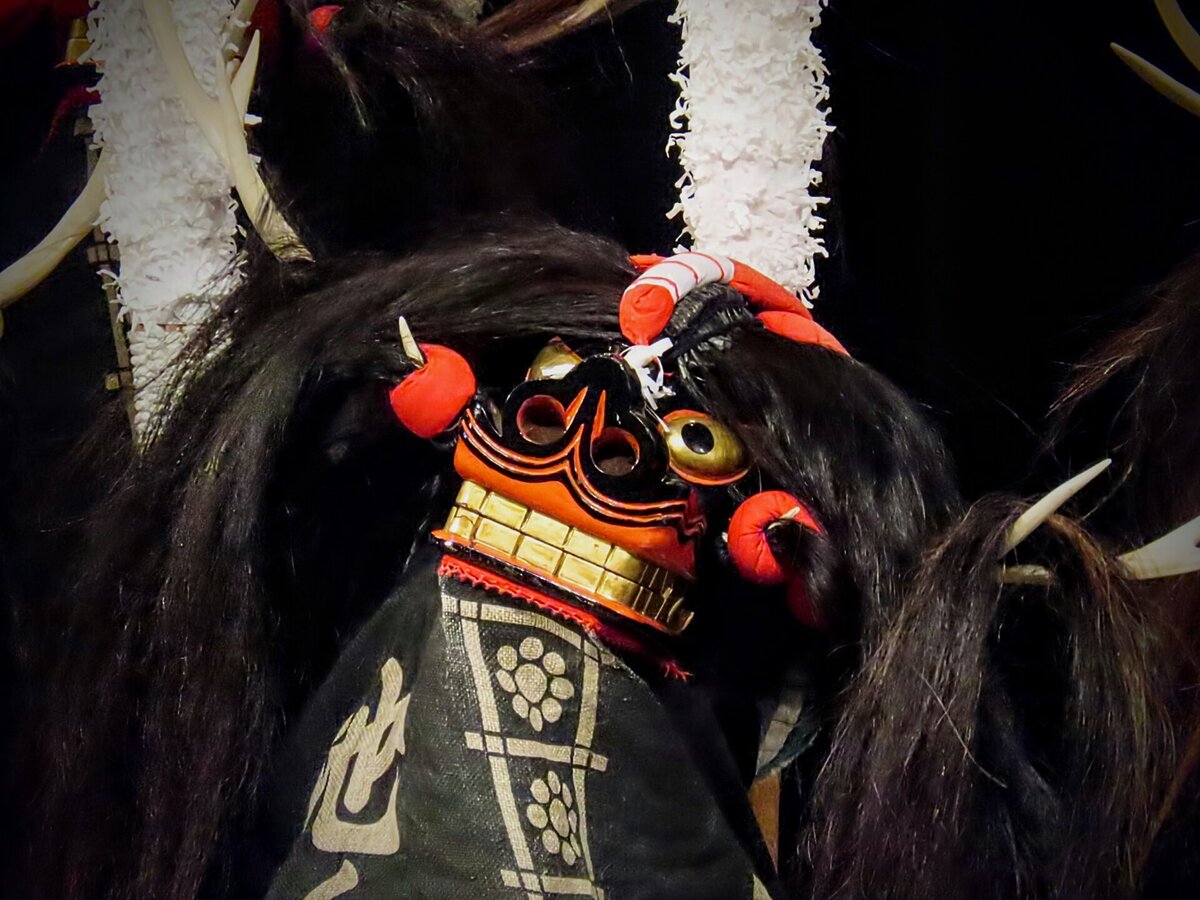
Date and the Southern folk entertainment "Shika Dance" | Local report on Sasara Hall's closure project [Iwate Prefecture]
table of contents
- 1 What is Deer Dance (Lion Dance)?
- 2 This event is Sasara Hall's closure project
- 3 9 deer dance groups that performed the performance
- 3.1 Kanezu-ryu Pumice Lion
- 3.2 Okuyama-kyo Mountain Dance
- 3.3 Kanazu-ryu Ite Lion
- 3.4 Gyoyama-style angular deer leap
- 3.5 Kanezu is expected to be Seki Lion
- 3.6 Kanazu-ryu River Lion
- 3.7 Mochida deer dance upstream of mountain climbing
- 3.8 Kanazu-ryu Field Tezaki Shishiryu
- 3.9 Masuzawa deer dance in the mountains hiking mountains
- 4 summary
One day in March, while watching X, I discovered a post from the Kanazu-ryu Pumice Shishiryu Preservation Society.
It's finally coming in two weeks.
— Kanazu-ryu Pumice Lion Preservation Society (@hirosekaruishi) March 8, 2025
This is the last opportunity for the lion to dance at Sasara Hall.
We look forward to seeing you at the venue for everyone who won't have a "next time" performance #Esashika Odori #Sasara Hall pic.twitter.com/Uiv8yYKLwz
Shishiodori is a folk art show that I've always wanted to see live . Furthermore, "There will be no next performance" Sasara Hall will close . if you miss this, there's no more next time is quite destructive.
This one word was the deciding factor, but I made a plan and went there!
What is Deer Dance (Lion Dance)?
Shishiodori is a folk performance that has been passed down mainly in the Date and Nanbu domains of the Edo period. The dancers, dressed in deer heads that resemble deer, and hide their upper body with cloth, perform the dance.
There are various theories about its origin, including the theory that it is memorial to a murdered deer, and the theory that it is a game-imitation that imitates a deer playing in the mountains and fields, and details are unknown.
Depending on the region and group, the kanji used may differ depending on the same name, Shishiodori, Shishiodori, and Shishiodori.
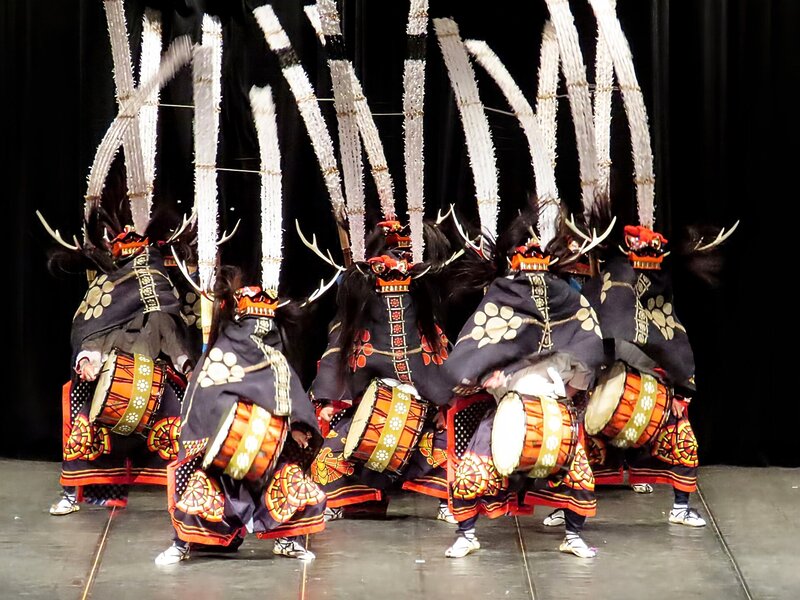
"Taiko dance" and "Maku Odori" (the taiko dance style " in which the dancer dances while playing taiko drums attached to the abdomen are mainly distributed in the Date Domain territory (from southern Iwate Prefecture to Miyagi Prefecture), and in the Maku Odori system, where dancers do not perform, it is distributed mainly in the Nanbu Domain territory (central to northern Iwate Prefecture).
The area around Oshu City (formerly Esashi City) where I visited this time was ruled by the Date Domain, so it seems that the "Taiko dance" style the sasara (an accessory made from shoji paper to the pieces of bamboo that is broken and is made to look like a monk).
Incidentally, since it was spreading in the Date Domain, the tradition of deer dance has been passed down in the area around Uwajima City, Ehime Prefecture,
Reference: Agency for Cultural Affairs - Cultural Heritage Online "Kubono's Eight Deer Dance"
The Kanazu-ryu and Gyoyama-ryu are two mainstream taiko drum dance styles in the Esashi region.
The Esashi region, which was originally the territory of the Date Domain, is home to many deer dances that are based on the drum dance, and there are two mainstream schools: the Kanazu-ryu and the Gyoyama-ryu
Kanezu-ryu Lion
The word "shishiodori" is mainly written as "shishi-ryu."
In 1779, a handbook was introduced from Kokubun Matsumori Village, Miyagi County (Matsumori, Izumi Ward, Sendai City, Miyagi Prefecture) to Ishiseki Village, Izawa County (now Esashi Inase Ishiseki City, Iwate Prefecture), and Kanazu Ishiseki Seki Shisai .
It is said that in 1793, the handbook was passed down from Inukai Kiyozo Akira, a samurai of Sendai, and in 1801, Shida-gun Tsujibashi Village (now Matsuyama Tsujibashi Bridge, Osaki City, Miyagi Prefecture) to Ishiseki Village.
Kanazu-ryu Yanagawa Lionaire born from Ishiseki Village to Yanagawa Village (now Esashiragawa, Oshu City, Iwate Prefecture) , and from there it spread to the nearby areas.
In fact, Kanezu-sei Sekishishi-Yao seems to have stored books such as handed down books that have been handed down. (Reference: Kanezu, as expected from the Sekishiryu )
Gyoyama-ryu deer dance
The word "shishiodori" is mainly written as "deer dance."
There is no clear description of the origin of "Yoyama" "Yosan" the "Kyuyomon" , one of the crests of the Date family , to be danced to Sendai Castle every year. This may be because Yosan" "Yosan" (Reference: Miyagi Prefecture official website - Ichisako Town Shika Odori pdf )
There are various theories about its origin and spread
- With its roots from the Yukiyama-ryu Yamaguchi school, whose founder was Matasuke from Yamaguchi Mansion in Daitocho, Higashiiwai District (now Daitocho, Ichinoseki City, Iwate Prefecture), his child, Kizaemon, played an important role in the spread of the species. (Reference: Okuyama-ryo Mountains, Jinokami Deer Dance )
- In 1599, Yoshirobei from Fieldzaki Village (now Esashiyagawa, Oshu City, Iwate Prefecture) was taught by Sato Chobei, the general of the Hachimando dance in Sendai Castle Town. (Reference: Hisada Shika Odori, Yukiyama Style )
- In 1982, a stone monument carved in Tokura Mitobe, Minamisanriku-cho, Motoyoshi-gun, Miyagi Prefecture was discovered during road construction in the Kyoho era, and it was written as "all offerings are a memorial service," which emerged, which suggests that Mitobe is the birthplace of the Gyoyama-style Kanoko-ryu. (Reference: Yukiyama-ryu, Mitobe Kako-ryu )
- It is said that it spread through Kuronuma Village, Tome County (now Nakata Town, Tome City, Miyagi Prefecture) and Tokuoka Village, Izawa District (now Izawa, Oshu City, Iwate Prefecture) and other places. (Reference: Mikajiri Shiroyama Style Mikajiri Shika Odori )
There are various types of organizations, such as: However, it is certainly unnatural to think that there is only one entrance to legend, so it may be normal to assume that it has been transmitted and spread through various routes in various times.
This event is Sasara Hall's closure project
The Esashi Athletics and Cultural Hall (Sasara Hall) is a cultural exchange facility with a maximum capacity of 970 people, which was built in a major renovation in 1988, predecessor of the Esashi Civic Gymnasium, which was built by the former Esashi City in 1969.
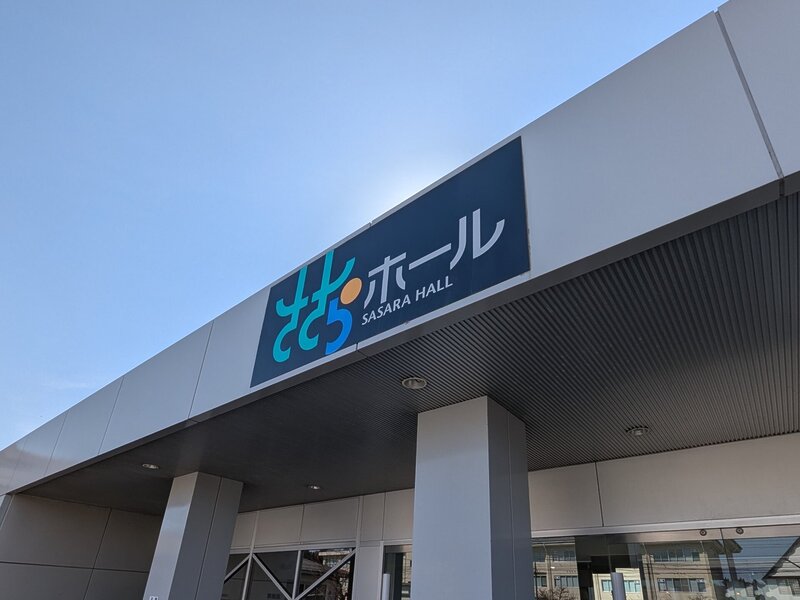
However, more than 55 years have passed since construction, and due to concerns about the aging of the building, the current city of Oshu has decided to close and abolish it at the end of March 2025 (Reiwa 7).
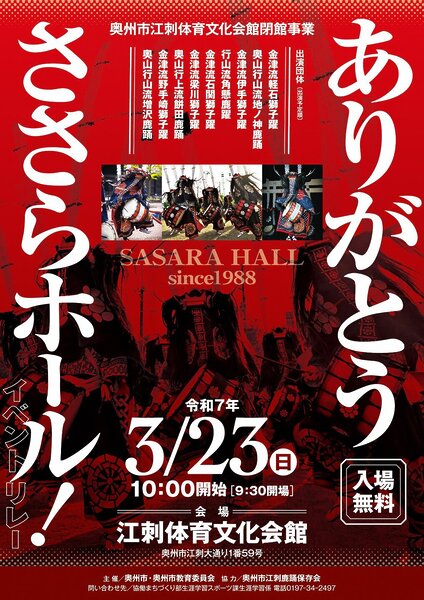
is the final event, titled "Thank you Sasara Hall! Event Relay," which has been held continuously since March 2024
9 deer dance groups that performed the performance
On the day, the performance was performed nine Shika dance groups in Oshu City, registered in the former Esashi City , and the content was luxurious and worthy of being a finale.
We will introduce all nine groups in chronological order of the day.
Kanezu-ryu Pumice Lion
The Kanazu-ryu Pumice Shishi-ryu was introduced to Esashi from the then Tsujibashi Village, Shida-gun, Miyagi Prefecture (now Matsuyama Tsujibashi, Osaki City, Miyagi Prefecture) about 290 years ago, and was born in 1910 by Hirose Pumice (now Esashi Hirose, Oshu City, Iwate Prefecture), and is now active as the third generation.
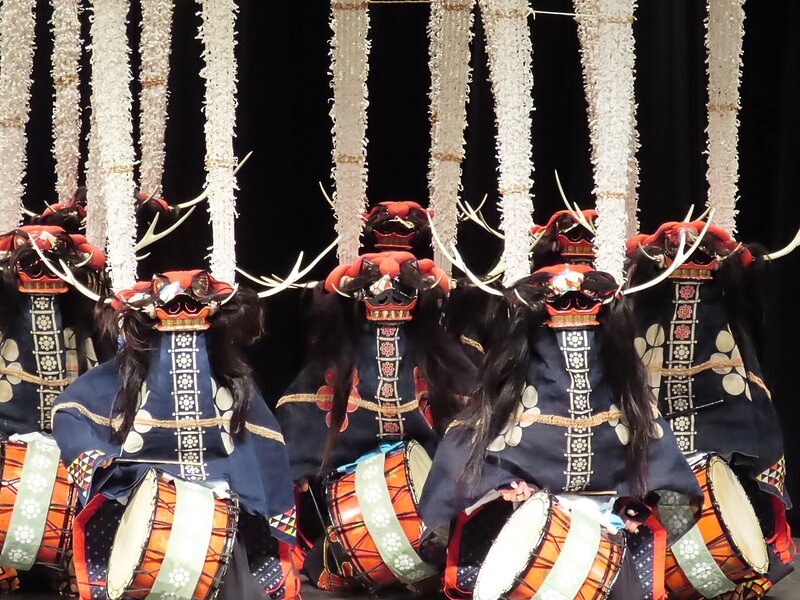
Performance: Reiniwa
Rei-kai is a ritual dance that is the basis of all dances, also known as the "first garden," and is danced while praying for a memorial service for ancestors and a bountiful harvest.

Kanezu-ryu Pumice Snow Leisure Related Links
- Kanazu-ryu Pumice Snowy Preservation Society Official X
- Kanazu-ryu Pumice Snowy Preservation Society Official Instagram
Okuyama-kyo Mountain Dance
The Chinokami Shika Odori is based on the Yukiyama-ryu Yamaguchi school, whose founder is Matasuke from Yamaguchi Mansion in Daitocho, Higashiiwai District (now Ichinoseki City), and has been passed down to the present day by his child, Kizaemon, a man named Enzo, the Iteji no Kami.
It is said that the relaxed dancing style and detailed leggings retain the characteristics of the time of the Yukiyama-ryu Yamaguchi-sect, and was designated as an intangible folk cultural property in the former Esashi city in 1977.
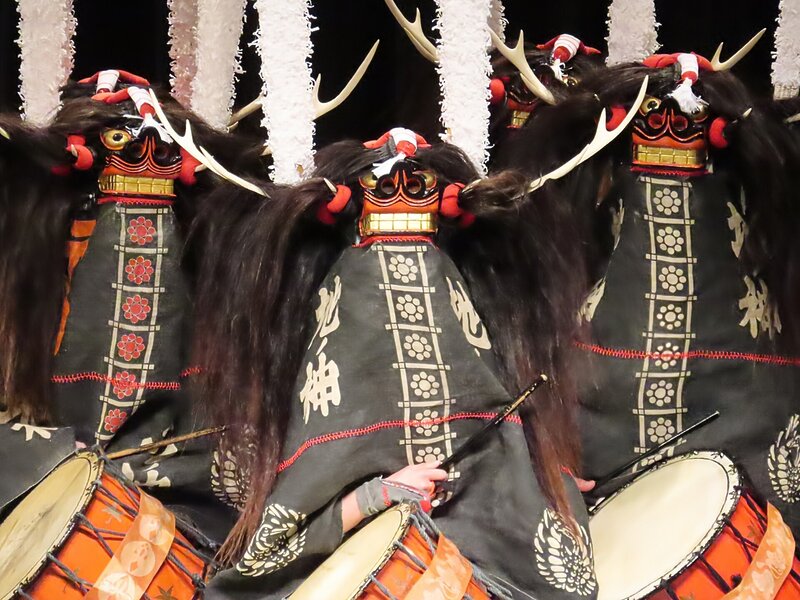
Performance: Teppo dance
The performance begins with a mountain run (hunter) firing a bullet into a frenzy of deer. The deer, who have submerged themselves and survived the mountain run, quietly get up and confirm that they are safe, but a group of them disappears.
They are discovered through hard searches by the bar (neutral) and others, but there are friends lying down without even shaking. The story is about a stag (neutral) and a spider grieving and singing a song through dialogue.
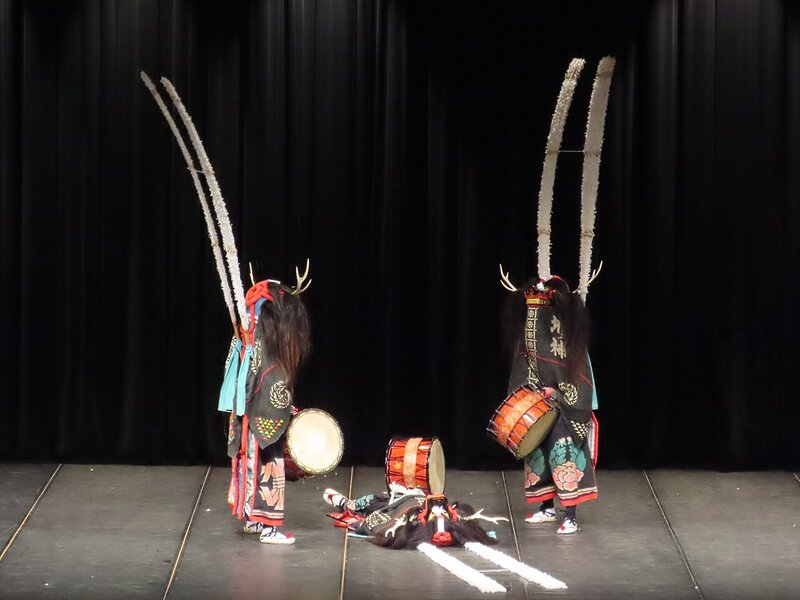
Okuyama-kyoyama-ryoji no Kamishika Dance Related Links
- Okuyama Gyochi no Kamishika Dance Official Website
- Okuyama-ryoyama-ryo no Kamishika Dance Official X
- Okuyama Gyochi no Kamishika Odori Official Instagram
Kanazu-ryu Ite Lion
Kanazu-ryu Ite Shishi-ryu was brought to Ite in 1903, and was born from Ishiseki to the Ryukawa River.
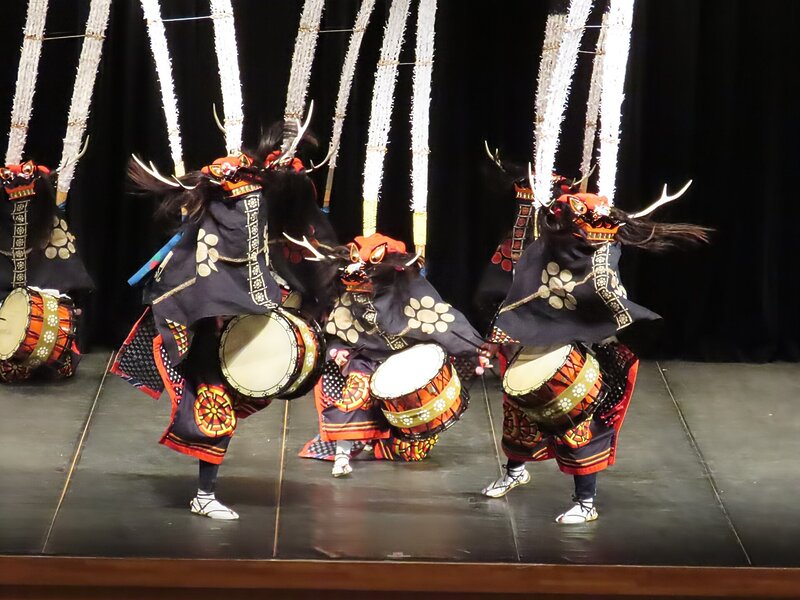
Performance: Shimagiri
It is considered to be a ritual dance along with the slashing ground, but the dance is danced in a completely different style of drums and movements, and while the skirmishes begin to play, the dance also corrects and plays out, expressing the rich expression of a lion.
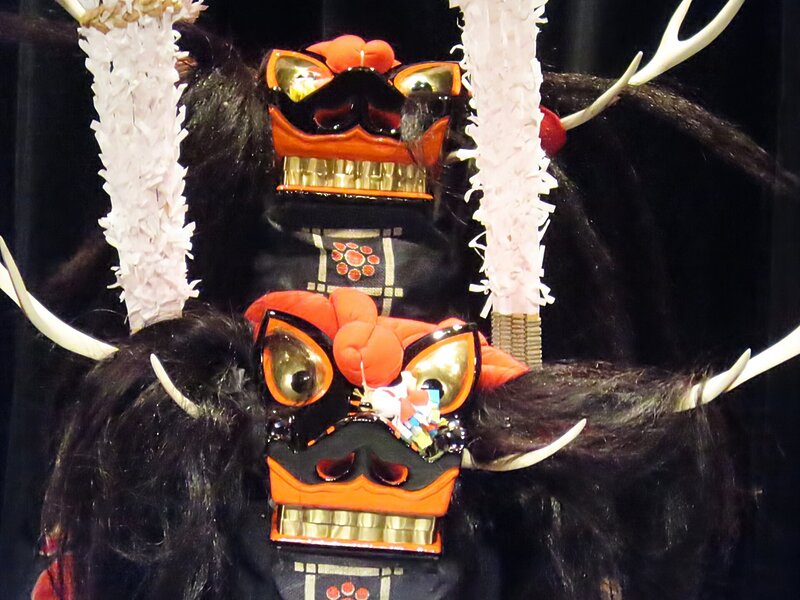
Kanazu-ryu Ite Shishi-ryu Related links
Gyoyama-style angular deer leap
Like the aforementioned Okuyama-ryu-san-ryu-san-ryu-san-ryu-san-ryu-san-ryu-san-ryu-san-ryu-san-ryu-san-ryu-san-ryu-san-ryu-san-ryu-san-ryu-san-ryu-san-ryu-san-ryu-san-ryu-san-ryu-san-ryu-san-ryu-san-ryu-san-ryu-san-ryu-san-ryu-san-ryu-san-ryu-san-ryu-san-ryu-san-ryu-san-ryu-san-ryu-san-ryu-san-ryu-san-ryu-san-ryu-san-ryu-san-ryu-san-ryu-san-ryu-san-ryu-san-ryu-san-ryu-san-ryu-san-ryu-san-ryu-san-ryu-san-ryu-san-ryu-san- ryu- The "neutral" costume is dyed with waka poems that symbolize the Yamaguchi school of Gyoyama.

Performance: Scarecrow Dance
A group of deer encounters scarecrows in a village. We will be watching the situation where we will change, while being vigilant about the incomprehensible things. The story depicts a scene where he is relieved to find out there is no danger and begins to play again.
This dance allows you to see the various changes in the deer's gestures, such as vigilance, observation, anxiety, and relief.

Kanezu is expected to be Seki Lion
Kanazu-sai Sekishishi-ryu is a group that is said to be the original Kanazu-style, passed down in the Esashi region. It has been passed down from Kokubun Matsumori Village, Miyagi County in 1779 (Matsumori, Izumi Ward, Sendai City, Miyagi Prefecture) for over 12 generations and over 180 years.
Unfortunately, history has been cut off once, but it was revived in 2002 and is now the 15th generation.
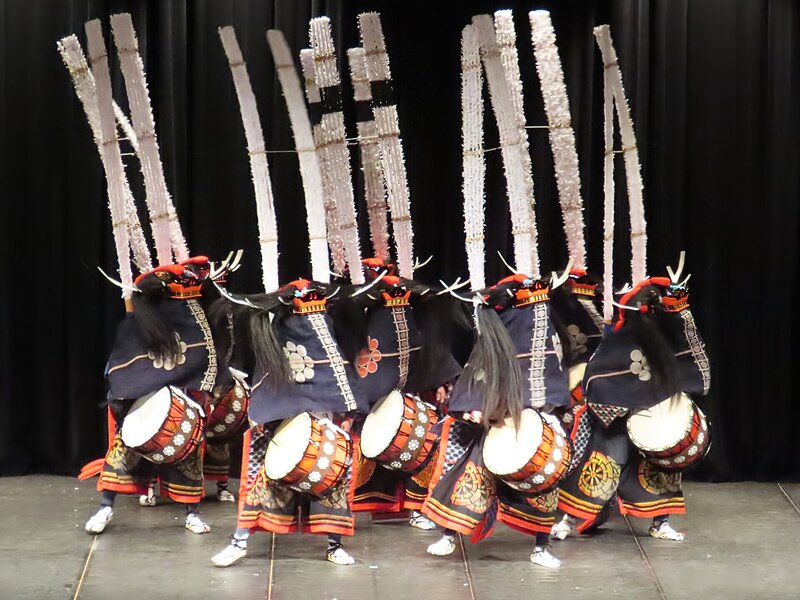
Performance: Scarecrow Dance
A group of deer encounters scarecrows in a village. We will be watching the situation where we will change, while being vigilant about the incomprehensible things. The story depicts a scene where he is relieved to find out there is no danger and begins to play again.
This dance allows you to see the various changes in the deer's gestures, such as vigilance, observation, anxiety, and relief.
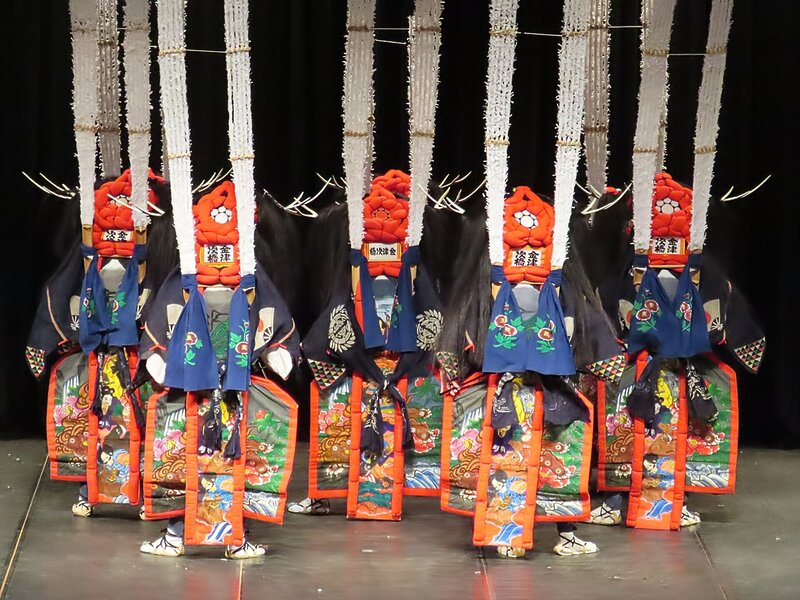
Kanezu Issei Seki Shishi-Lee Related Links
- Kanezu-sai-shishi-ryu Official website
- Kanezu-sai-shishi-ryu Official X
- Kanezu Issei Seki Shishiryu Official Instagram
Kanazu-ryu River Lion
The Kanazu-ryu River Shishi-ryu was born in 1828 from Ishiseki Village and was introduced to Yanagawa Kuriozawa. It is said that Lion River spreads to many areas.
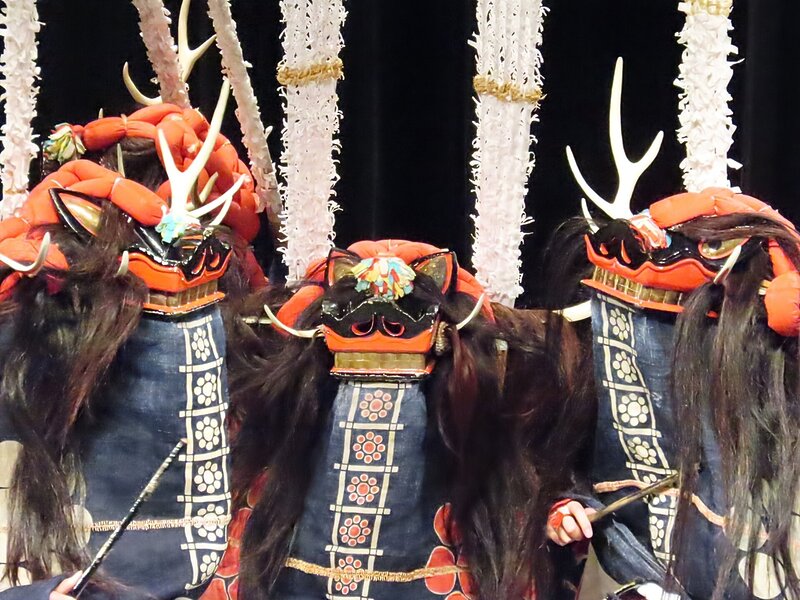
Performance: Turning back
It is considered to be a ritual dance along with Reiku and Shimagiri.
This dance emphasizes the "movement" part of the deer dance, and is the most dynamic dance, with its back and forth flying and bouncing.
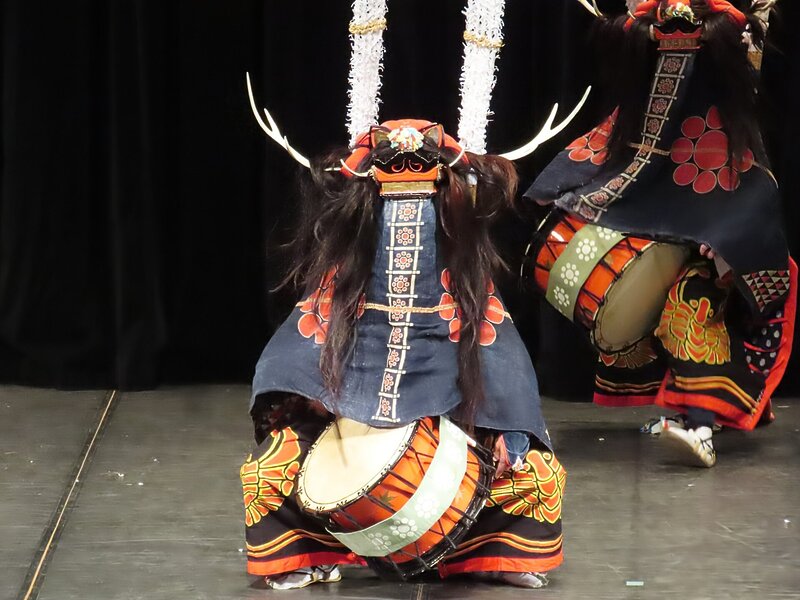
Kanazu-ryu Yanagawa Lionaire Related links
- Oshu City Esashi River Promotion Association – Kanazu-ryu Yankawa Lion
- Kanazu-ryu Yanagawa Children's Shishi-ryu Official X
- Kanazu-ryu Yanagawa Children's Shishi-ryu Official Instagram
Mochida deer dance upstream of mountain climbing
The Mochida Shika Odori is a deer dance that is said to have been taught by the Kamozawa Shika Odori, a mountain climbing mountain in Hirose (now Esashi Hirose, Oshu City, Iwate Prefecture), which is the oldest legendary source, and was born in 1332.
In 1917, Emperor Showa, who was the young Crown Prince at the time, was viewed as a viewer, and with permission from the Imperial Household Agency, the "Gosan Paulownia Crest" was dyed at the top of the front makurogi.
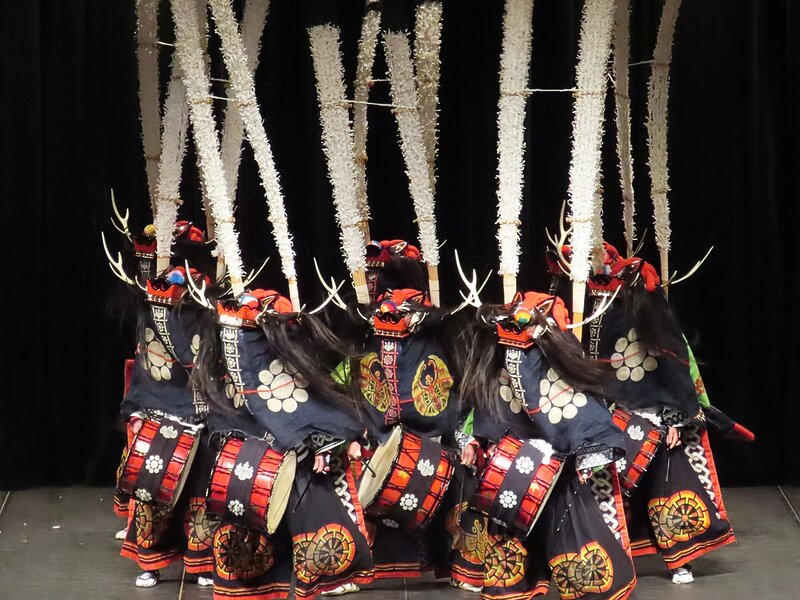
Performance: Female deer hidden
From among the frivolous group of deer, the female deer is hidden by a mad deer, and the female deer finds it and fights repeatedly for battle.
The story is about Oshika asking his friends to support him and somehow managed to get back.
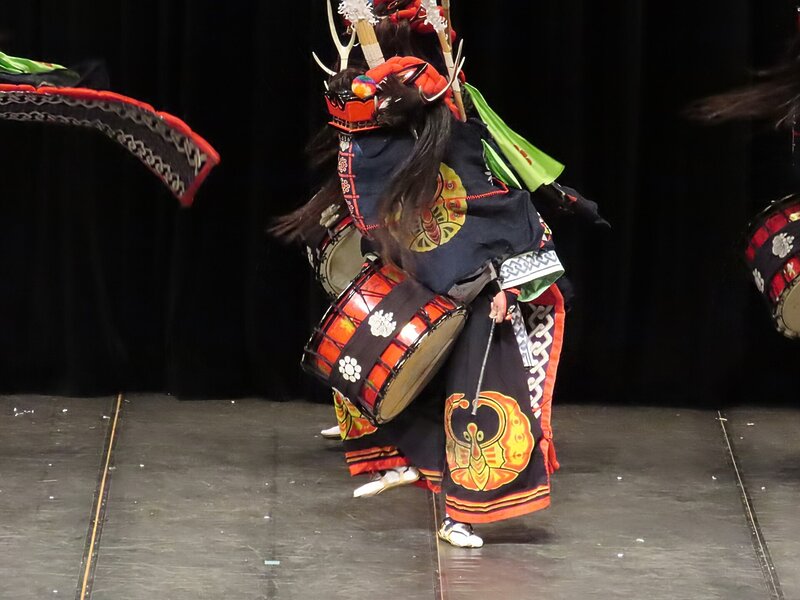
Mochida Shika Odori, Upper Slope, Related Links
Kanazu-ryu Field Tezaki Shishiryu
Kanazu-ryu Notezaki Shishi-ryu was introduced to Kanazu-ryu Yankawa Shishi-ryu in 1971, and was born in 1981 when he taught everything about dancing. Since 2012, he has called himself the Kanazu-ryu Notezaki Shishi-ryu, and is now passed down to the third generation.
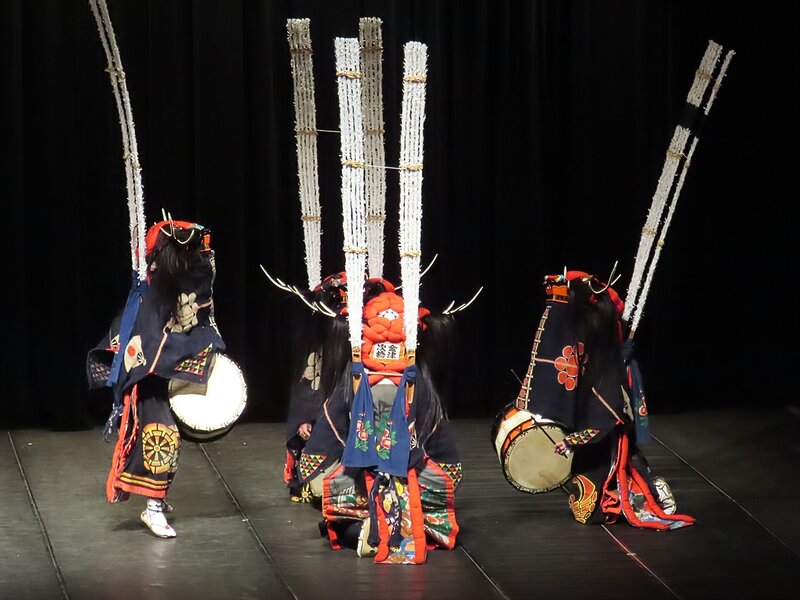
Performance: Female deer hidden
From among the frivolous group of deer, the female deer is hidden by a mad deer, and the female deer finds it and fights repeatedly for battle.
The story is about Oshika asking his friends to support him and somehow managed to get back.
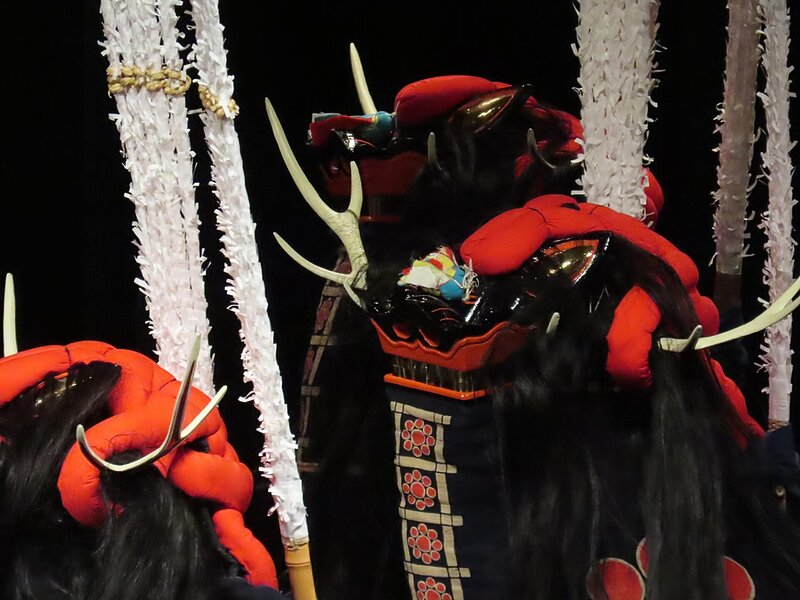
Kanazu-ryu Notezaki Shishiurei Related Links
- Oshu City Esashi Ryogawa Promotion Association – Kanazu-ryu Notezaki Shishiryu
- Kanazu-ryu Notezaki Shishiryu Official X
Masuzawa deer dance in the mountains hiking mountains
the Okuyama-ryo Masuzawa Shika Odori was handed down in 1827 from Ite Village, Esashi County. It is now inherited until the 13th generation.

Performance: Reiniwa
Rei-kai is a ritual dance that is the basis of all dances, also known as the "first garden," and is danced while praying for a memorial service for ancestors and a bountiful harvest.
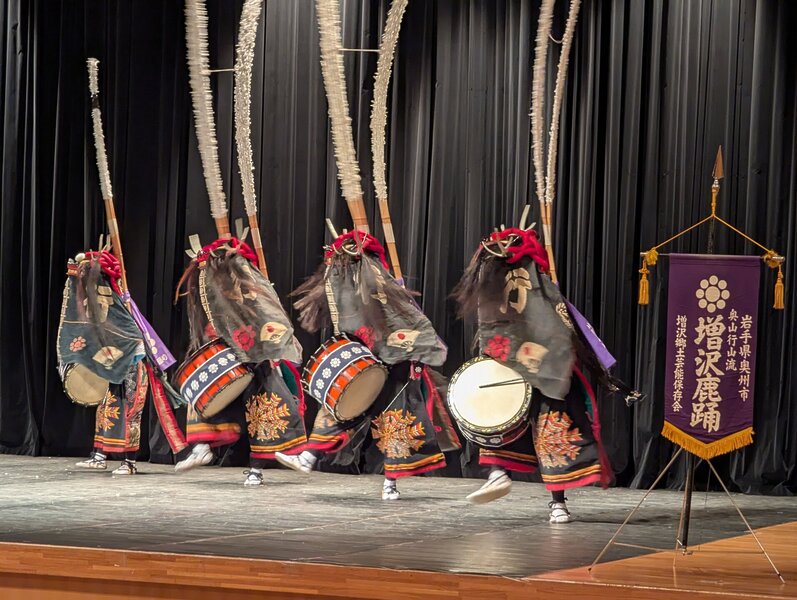
Okuyama-ryu Masuzawa Shika Odori Related links
summary
they performed a simultaneous performance that went beyond the boundaries of schools, "Hyakushika Daigunbu."
The Hyakuji Ogun Dance is a deer dance performance performed at the annual Esashi Jinku Festival and the Esashi Summer Festival , and the deer dance, which is usually eight, is danced together across groups and schools, and a powerful the Sasara Hall was performed.
It has a long tradition, and more than anything, it's purely cool! The folk performing arts "Shiba Dance", but when viewed throughout Iwate, there are many more organizations, and the number of them increases even more when Miyagi Prefecture is included.
If you're interested but don't know where to go and see it, why not the Esashi Jinpuku Festival held every May 4th , or the Esashi Summer Festival held every year on August 16th , and first experience the power of the Hyakuji Group Dance?



![The specialty of Genbikei, "Flying Dango," is definitely worth a visit! Delicious activities! [Ichinoseki City, Iwate Prefecture] Genbikei bus stop](https://jp.neft.asia/wp-content/uploads/2017/04/IMG_5931-150x150.jpg)
![Bottle Don is the definitive Sanriku souvenir that looks delicious! [Iwate Prefecture] Bottle don (abalone, scallop, salmon roe)](https://jp.neft.asia/wp-content/uploads/2023/06/IMG_5048-150x150.jpg)
![Ryusen-no-no-no-no-no-no-no-no-no-no-no-no-no-no-no-no-no-no-no-no-no-no-no-no-no-no-no-no-no-no-no-no-no-no-no-no-no-no-no-no-no-no-no-no-no-no-no-no-no-no-no-no-no-no-no-no-no-no-no-no-no-no-no-no-no-no-no-no-no-no-no-no-no-no-no-no-no-no-no-no-no-no-no-no-no-no-no-no-no-no-no-no-no-no-no-no-no-no-no-no-no-no-no-no-no-no-no-no-no-no-no-no-no-no-no-no-no-no-no-no-no-no-no-no-no-no-no-no-no-no-no-no-no-no-no-no-no-no-no-no-no-no-no-no-no-no-no-no-no-no-no-no-no-no-no-no-no-no-no-no-no-no-no-no-no-no-no-no-no-no-no-no-no-no-no-no-no-no-no-no-no-no-no-no-no-no-no-no-no-no-no-no-no-no-no-no-no-no-no-no-no-no-no-no-no-no-no-no-no-no-no-no-no-no-no-no-no-no-no-no-no-no-no-no-no-no-no-no-no-no-no-no-no-no-no-no-no-no-no-no-no-no-no-no-no-no-no-no-no-no-no-no-no-no- [Iwate Prefecture] Ryusendo Cave (first underground lake)](https://jp.neft.asia/wp-content/uploads/2023/07/PXL_20230512_052246926.NIGHT_-150x150.jpg)
![[Series ②: The role of the previous nine years and the role of the second three years] The role of the previous nine years is from the truce to the battle again, and the Kokufu army is struggling Taga Castle Ruins](https://jp.neft.asia/wp-content/uploads/2023/11/a0b8b1213124e7a13c7308fa81e053a2-150x150.jpg)
![[Iwate Prefecture] Soft-serve ice cream with sake, miso and wasabi flavor! Why are the soft serve ice cream eaten at roadside stations so delicious? There's also school lunches! Iwate Prefecture Catch](https://jp.neft.asia/wp-content/uploads/2025/06/915fd0ce722ab0f21e74864401170847-150x150.jpg)

!["Negaseki" is one of the three ancient Oshu sekies that surpasses Minamoto Yoshitsune and Matsuo Basho [Tsuruoka City, Yamagata Prefecture] 3809167_m](https://jp.neft.asia/wp-content/uploads/2023/02/3809167_m-150x150.jpg)


